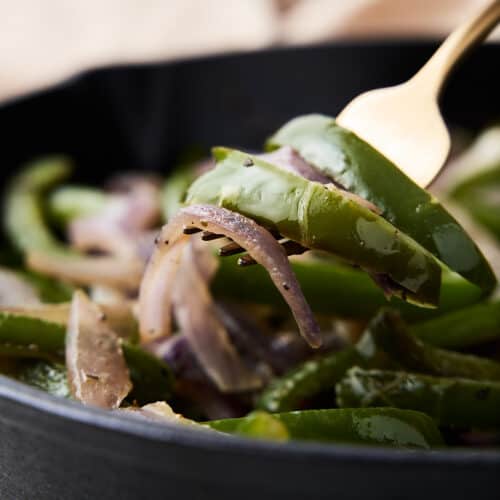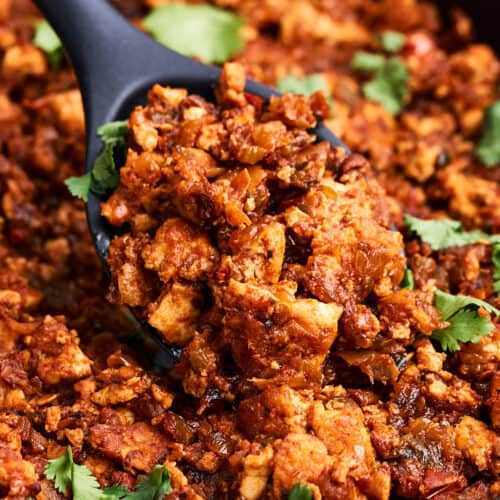Calabacitas
This calabacitas recipe is creamy, tender, and satisfying! Mexican squash is cooked until tender and mixed with corn, onion, tomatoes, spicy peppers, and savory seasonings. It makes the perfect taco filling or side dish instead of beans and rice at summer barbecues, potlucks, and other events.

With minimal ingredients and a 20-minute cooking process, this calabacitas recipe is ideal for busy weeknights or last-minute meals. If you’re looking for more light and refreshing squash dishes, check out my air fryer zucchini.
Why I love this recipe
Calabacitas is a quick and easy recipe that requires very little expertise in the kitchen. Trust me, it’s not hard to make delicious food for your friends and family!
Since it’s vegetable-forward and low in calories, this simple, light, and healthy dish is suitable for a wide range of dietary needs and preferences. Plus, everything is made in one skillet, making cleanup a breeze!
It’s packed with soft, tender pieces of squash, sweet corn, juicy tomatoes, savory onions, umami-rich vegan cheese, and a hint of spice from jalapeno peppers. The result? A satisfying and aromatic side dish or taco filling.
Ingredient notes
You only need 11 ingredients for this calabacitas recipe! Find full a breakdown and suitable substitutes below.

Calabacitas (squash)
Creates the bulk of the recipe, providing a sweet and tender flavor. You can use zucchini, Mexican squash, yellow squash, or any summer squash available near you.
Corn
Adds bursts of sweet flavor and fiber to this calabacitas recipe. I recommend using fresh corn for the most intense flavors.
Substitute: If you don’t have fresh corn, frozen or canned corn will work. Use an equivalent amount, and make sure to let frozen corn thaw thoroughly.
Green chiles
I love adding jalapeno peppers for a little kick. If you’re sensitive to spice, use poblano peppers or green bell peppers. To turn the heat up, try serrano peppers.
Roma tomatoes
Provide a zesty, vibrant, and juicy element. Roma tomatoes are the ideal choice here since they have low water content.
Substitute: If you don’t have Roma tomatoes, you can also use cherry or grape tomatoes in a pinch.
Spices
Mexican oregano and ground cumin create the perfect blend of herbaceous, earthy, and robust flavors to balance the fresh veggies.
Substitute: If you don’t have Mexican oregano, try an equivalent amount of marjoram. If you don’t have cumin on hand, use coriander in equal amounts.
Vegan cheese
I like to add vegan mozzarella directly into my calabacitas recipe for a rich, creamy, and umami element. You can also omit the cheese for a lighter dish.
For a complete ingredient list and step-by-step guide, scroll down to the recipe card.
How to make
Learn the best way to make calabacitas with my straightforward, easy-to-follow instructions. Look for the tips in green throughout this section for consistent and successful results! Also, you can watch my video tutorial down below!
Preparation
Start by washing all the vegetables thoroughly under cold running water. Peel and finely mince the jalapeno pepper and garlic cloves, and chop the other veggies.
Pat the vegetables dry after washing so the oil coats them more evenly during sautéing, leading to better flavor development.
Cooking
Step 1
Heat the olive oil in a large skillet over medium. Once hot, add the onions and cook them for 3 minutes until they are translucent.
Give the onions a head start so they have time to soften and release their sweetness, which forms the base flavor of this dish.

Step 2
Add the jalapeno, garlic, squash, corn, tomatoes, Mexican oregano, cumin, salt, and pepper. Reduce the heat to just over low, cover the pan, and cook the mixture for 8-9 minutes until the squash is tender.
Keep the heat low after adding all the vegetables to help meld the flavors together without overcooking any individual ingredient.

Step 3
Add vegan mozzarella shreds and cook with the lid on for an additional 1-2 minutes until the cheese melts. Serve it warm as a side or light meal. Happy eating!
Adding cheese at the end and allowing it to melt with the residual heat incorporates it smoothly into the dish without turning it rubbery.

Expert tip
To achieve the perfect balance of flavors and textures, you need to layer the vegetables throughout the cooking process. Let the onions sauté first before adding the faster-cooking vegetables.
I suggest using a non-stick skillet for this recipe as well. Since you’re working with mainly vegetables and potentially vegan cheese, it makes cooking and cleanup a whole lot easier.
On that note, don’t rush the cooking process! Slow and gentle cooking brings out the sweetness of the vegetables, making your calabacitas recipe taste so much better.
Serving suggestions
For an extra pop of flavor, top your calabacitas recipe with vegan queso fresco, queso cotija, cilantro, avocado, lime, or hot sauce. You can also bulk it up with cooked white rice or vegan Spanish rice.
Serve calabacitas as a filling inside flour tortillas or corn tortillas with a dollop of refried beans. Or, pair it alongside dishes like enchiladas rojas, vegan empanadas, and tacos de canasta.

Cooking tips
Use any summer squash: If you can’t find Mexican squash, replace it with any variety of summer squash (yellow or green zucchini, pattypan, globe, crookneck, etc).
Cut the veggies evenly: Cut the calabactias and other vegetables into even, bite-size pieces to ensure everything cooks consistently.
Use a large skillet: Using a large skillet prevents the vegetables from overcrowding and helps them cook at the same rate.
Cook with a lid: Covering the pan helps trap the steam, which steams the vegetables more quickly. Plus, it perfectly melts the cheese at the end.
Don’t cook too long: You want the squash and other vegetables to be tender yet still vibrant and structured. Keep a close eye on everything as it cooks.
Frequently asked questions
A characteristic of all summer squashes is their thin, tender skin, so you do not need to peel them before consumption.
Yes, you can use frozen vegetables. Thaw and drain them well before cooking to avoid adding extra moisture to the dish. However, remember that the texture and flavor might slightly differ from fresh vegetables.
The squash should be tender but still hold its shape. You can test it by piercing a piece with a fork — it should go in easily without much resistance.

Storing & reheating
This calabacitas recipe makes for great leftovers, so don’t be afraid to prep a large batch! Let it cool to room temperature before transferring it to an airtight container.
Fridge
This dish can be stored in the refrigerator for up to 5 days. To maintain its freshness, place the cooled mixture in an airtight container.
Freezer
Freezing calabacitas is possible, but it may slightly alter the texture of the vegetables. If you choose to freeze it, transfer it to freezer-safe bags or containers for up to 3 months.
Reheating
You can cook this dish in advance and store it in the fridge. Reheat it gently, covered, over low heat on the stove, or in the microwave, adding a little water or vegetable broth to keep it moist.
Watch how to make it
More side dishes
Hungry for more?
If you enjoyed this recipe, please consider leaving a star rating and a comment down below! Your feedback not only helps others discover our blog but also gives us valuable insights from your experience.
Don’t forget to subscribe to our newsletter for the latest recipes, and check out our shop for our top kitchen recommendations. Thank you for supporting BBV!
Recipe

Easy Calabacitas Recipe
Equipment
- Skillet
- Grater
- Chef's knife & cutting board
Ingredients
- 1 tablespoon olive oil
- ½ large white onion, diced
- 1 large jalapeno, seeded & diced
- 2 cloves garlic, minced
- 1 ½ pounds Mexican squash, sliced into quarters
- 1 cup corn kernels
- 2 Roma tomatoes, diced
- ¼ teaspoon Mexican oregano
- ¼ teaspoon cumin
- Salt & pepper to taste
- ⅔ cup vegan mozzarella, shredded
Toppings
Instructions
- Heat the olive oil in a large skillet over medium. Once hot, add the onions and cook for about 3 minutes until translucent.
- Add the jalapeno, garlic, squash, corn, tomatoes, Mexican oregano, cumin, salt, and pepper. Reduce the heat to just over low, cover, and cook for ~8-9 minutes, stirring occasionally, until the squash is tender.
- Add the vegan mozzarella shreds, and cook with the lid on for an additional 1-2 minutes until the cheese melts.
- Serve your calabacitas warm with vegan queso fresco or cotija cheese and cilantro on top. Happy eating!
Notes
Nutrition
Note: I’ve updated this post to include new information and helpful tips about the recipe.
Justine Drosdovech is a food writer, photographer, and one of the founders of Broke Bank Vegan. She is a self-taught plant-based chef but uses her healthcare background to craft dishes that are both delicious and nourishing.





